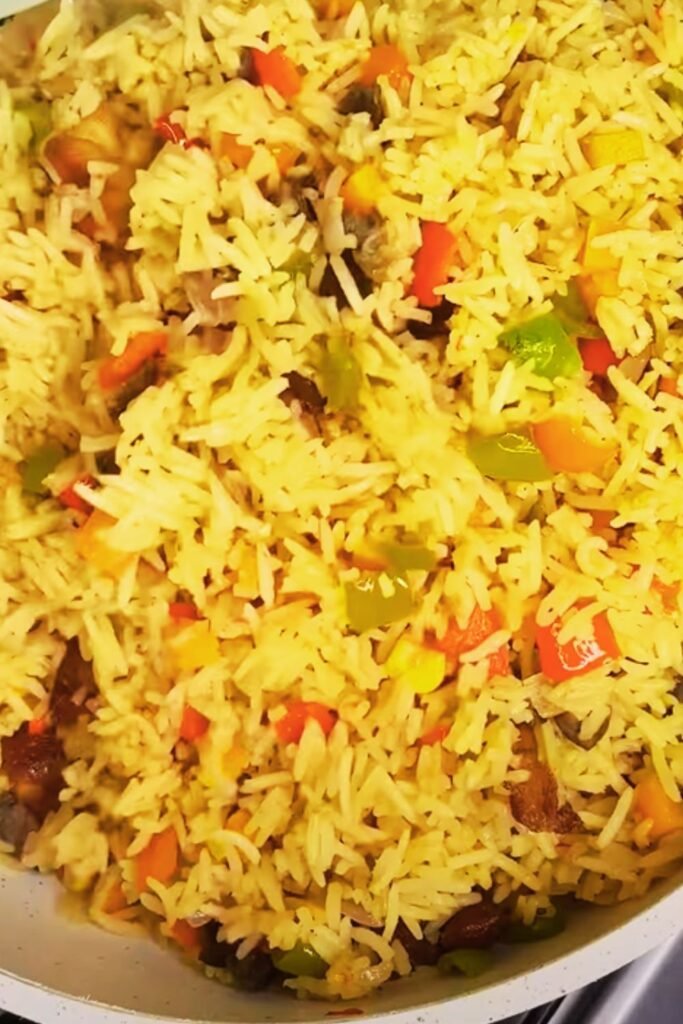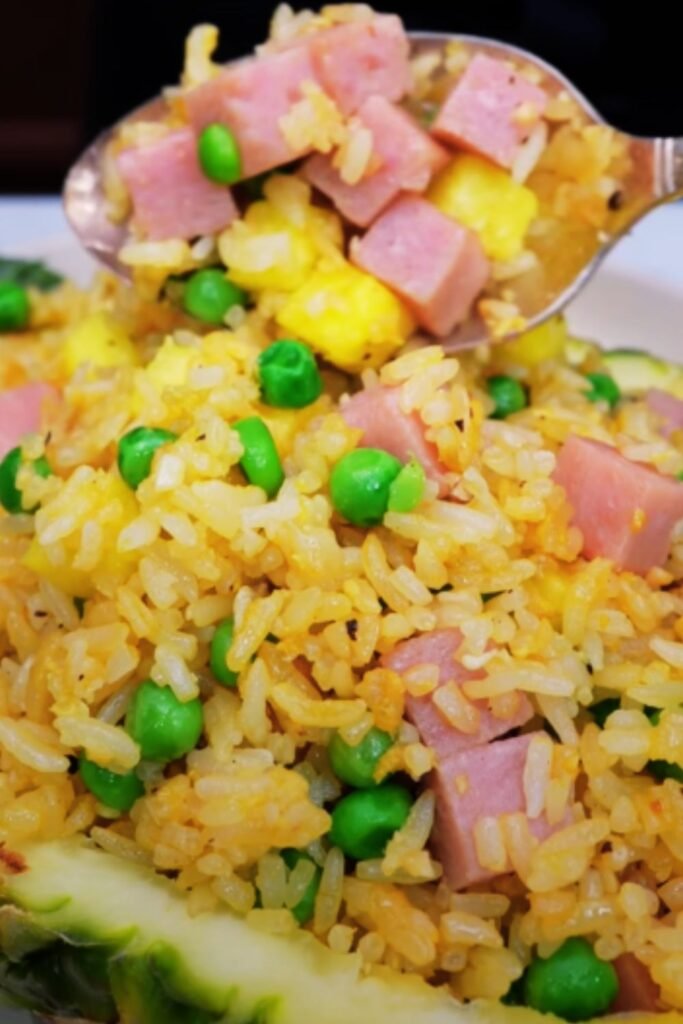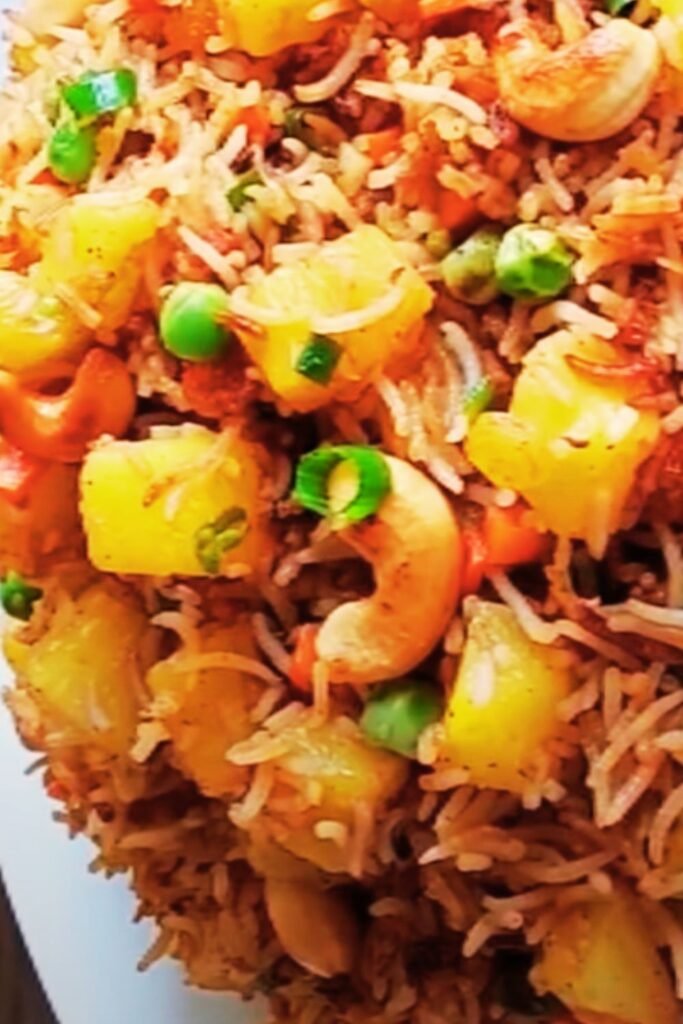I’ve been perfecting my pineapple fried rice recipe for over a decade, and I can confidently say it’s become one of my most requested dishes at dinner parties. There’s something magical about the way sweet, juicy pineapple chunks meld with savory rice, creating a harmony that transports you straight to a tropical paradise. Today, I’m sharing everything I’ve learned about crafting the perfect pineapple fried rice that will have your guests asking for seconds—and thirds.

The beauty of pineapple fried rice lies not just in its stunning presentation when served inside a hollowed pineapple shell, but in its perfect balance of flavors and textures. This Thai-inspired dish combines the sweetness of fresh pineapple with the umami richness of soy sauce, the crunch of vegetables, and the protein punch of your choice—whether that’s shrimp, chicken, or tofu for my vegetarian friends.
Understanding the Foundation: What Makes Great Pineapple Fried Rice
Before diving into my step-by-step method, let me share what I’ve discovered makes the difference between mediocre and magnificent pineapple fried rice. The secret isn’t just in the ingredients—it’s in understanding how each component contributes to the final dish.
Day-Old Rice: This is non-negotiable in my kitchen. Fresh rice contains too much moisture and will result in a mushy, clumpy mess. I always cook my jasmine rice a day ahead and refrigerate it overnight. The cooling process allows the rice grains to firm up and separate, creating the perfect texture for frying.
Pineapple Selection: Not all pineapples are created equal for this dish. I look for pineapples that are ripe but still firm—they should give slightly when pressed but not be mushy. The flesh should be golden yellow with a sweet aroma at the base. Overly ripe pineapples will break down during cooking and make your rice soggy.
High Heat Cooking: This technique, borrowed from professional wok cooking, is crucial for achieving that coveted “wok hei” or breath of the wok flavor. High heat prevents the rice from steaming in its own moisture and creates those slightly crispy, caramelized edges that make restaurant-style fried rice so irresistible.
Essential Ingredients and Their Roles
Let me break down each ingredient and explain why it’s important for achieving the perfect balance:
Base Ingredients:
- Jasmine rice (day-old, refrigerated)
- Fresh pineapple chunks
- Eggs
- Garlic and shallots
- Fish sauce or soy sauce
- Vegetable oil with high smoke point
Protein Options:
- Shrimp (my personal favorite)
- Chicken breast or thigh
- Chinese sausage (lap cheong)
- Tofu for vegetarian version
Vegetables and Aromatics:
- Red bell pepper
- Green onions
- Thai chilies (optional)
- Cashews or peanuts
- Fresh cilantro
Seasoning Balance:
- Palm sugar or brown sugar
- Lime juice
- White pepper
- Curry powder (optional but recommended)

My Foolproof Method: Step-by-Step Instructions
After years of trial and error, I’ve developed a method that consistently produces restaurant-quality results. Here’s my exact process:
Preparation Phase (15 minutes)
I start by preparing all my ingredients before turning on the heat. This dish cooks quickly, and having everything ready prevents overcooking or burning.
- Rice Preparation: Remove day-old rice from refrigerator and break up any clumps with my fingers. I spread it on a large plate to bring it closer to room temperature.
- Pineapple Prep: If using a whole pineapple for presentation, I cut off the top third and carefully hollow out the flesh, leaving about half an inch of flesh attached to the shell. I cut the extracted flesh into bite-sized chunks, removing the tough core.
- Protein Preparation: For shrimp, I peel, devein, and pat dry. For chicken, I cut into small, uniform pieces. I season lightly with salt and white pepper.
- Vegetable Prep: I dice shallots finely, mince garlic, cut bell peppers into small cubes, and slice green onions, separating white and green parts.
Cooking Process (12-15 minutes)
Step 1: Protein First I heat my wok or large skillet over high heat until it’s smoking. Adding oil, I quickly cook my protein until just done—about 2-3 minutes for shrimp, 4-5 for chicken. I remove and set aside.
Step 2: Aromatics Foundation In the same pan, I add more oil if needed and stir-fry minced garlic and shallot whites until fragrant, about 30 seconds. The key is not to let them brown.
Step 3: Egg Scramble I push aromatics to one side and pour beaten eggs into the empty space. I let them set for about 10 seconds, then scramble gently, keeping them slightly underdone as they’ll continue cooking.
Step 4: Rice Integration This is where the magic happens. I add the day-old rice and immediately start breaking it up with my spatula, mixing it with the eggs and aromatics. I keep the heat high and toss constantly for about 3-4 minutes until the rice is heated through and starting to get crispy edges.
Step 5: Seasoning Layer I add fish sauce (or soy sauce), a pinch of curry powder, and palm sugar. I continue tossing for another minute, ensuring even distribution.
Step 6: Final Assembly I return the cooked protein to the pan, add pineapple chunks, bell peppers, and cashews. I toss everything together for 2-3 minutes until the pineapple is heated through but still holds its shape.
Step 7: Finishing Touches Off the heat, I add lime juice, green onion tops, and fresh cilantro. A final toss and it’s ready to serve.
Nutritional Benefits and Dietary Considerations
| Nutrient | Amount per Serving | % Daily Value | Health Benefits |
|---|---|---|---|
| Calories | 320-380 | 16-19% | Moderate calorie meal |
| Protein | 18-25g | 36-50% | Muscle maintenance and satiety |
| Carbohydrates | 45-55g | 15-18% | Energy provision |
| Fiber | 3-4g | 12-16% | Digestive health |
| Vitamin C | 35-45mg | 39-50% | Immune system support |
| Vitamin A | 850-1200 IU | 17-24% | Eye health and immunity |
| Iron | 2-3mg | 11-17% | Oxygen transport |
| Potassium | 280-350mg | 8-10% | Heart and muscle function |
The pineapple provides natural enzymes like bromelain, which aids digestion and has anti-inflammatory properties. The combination of rice and protein creates a complete amino acid profile, making this dish nutritionally balanced.
For dietary modifications, I’ve successfully adapted this recipe for various needs:
- Gluten-free: Use tamari instead of soy sauce
- Vegetarian: Replace fish sauce with extra soy sauce and add more vegetables
- Vegan: Omit eggs and use firm tofu as protein
- Low-sodium: Reduce sauce quantities and rely more on fresh herbs and lime juice

Flavor Profile Analysis and Variations
The beauty of pineapple fried rice lies in its complex flavor profile that hits all five taste sensations:
Sweet: Fresh pineapple and palm sugar provide natural sweetness that balances the savory elements Salty: Fish sauce and soy sauce contribute umami depth and salinity Sour: Lime juice adds brightness and prevents the dish from becoming cloying Spicy: Thai chilies or white pepper provide gentle heat Umami: The combination of fish sauce, eggs, and properly caramelized rice creates rich, savory notes
Regional Variations I’ve Explored
Thai Style: The original version I learned uses fish sauce, palm sugar, and Thai chilies. It’s typically served in a pineapple shell with a sprinkle of crushed peanuts.
Chinese Style: This version incorporates Chinese sausage (lap cheong) and uses light and dark soy sauces for color and flavor complexity.
Hawaiian Style: A fusion approach that includes spam or Portuguese sausage, reflecting Hawaii’s multicultural culinary landscape.
Indian Style: Uses basmati rice, curry powder, and Indian spices like turmeric and garam masala for a more aromatic profile.
Vietnamese Style: Incorporates nuoc mam (Vietnamese fish sauce) and often includes dried shrimp for additional umami depth.
Ingredient Quality and Sourcing Tips
Through my years of cooking, I’ve learned that ingredient quality makes an enormous difference in the final dish. Here’s what I look for:
Rice Selection
I exclusively use jasmine rice for its aromatic quality and perfect texture when day-old. The grains separate beautifully and don’t become mushy during high-heat cooking. Basmati works as a substitute, but I avoid short-grain varieties as they tend to clump.
Pineapple Quality Indicators
A good pineapple for cooking should pass the “sniff test”—sweet aroma at the base without any fermented smell. The skin should be golden with some give when pressed gently. I avoid pineapples with dark spots or overly soft areas.
Protein Considerations
For shrimp, I prefer wild-caught when possible, as they have better texture and flavor. With chicken, I use thigh meat for more flavor and moisture retention, though breast meat works if you prefer leaner protein.
Essential Sauces
Authentic fish sauce makes a significant difference. I recommend Red Boat or Three Crabs brands for their clean, non-fishy taste. For soy sauce, I use light soy for saltiness and dark soy for color and slight sweetness.
Advanced Techniques and Professional Tips
After mastering the basic recipe, I’ve developed several advanced techniques that elevate the dish:
Wok Hei Achievement
This Cantonese term refers to the “breath of the wok”—that slightly smoky, caramelized flavor achieved through high-heat cooking. To achieve this at home:
- Use the highest heat setting your stove allows
- Ensure your pan is properly seasoned (for carbon steel or cast iron)
- Don’t overcrowd the pan—cook in batches if necessary
- Keep ingredients moving constantly
- Listen for sizzling sounds—silence means your heat is too low
Rice Texture Mastery
Perfect fried rice has individual grains that are slightly chewy with some crispy edges. My technique:
- Spread day-old rice on a sheet pan and let it air-dry for 30 minutes before cooking
- Use a 1:1 ratio of oil to rice weight for proper coating
- Press rice against the pan bottom for 30-45 seconds between tosses to develop crispy spots
- Add liquids gradually to prevent steaming
Pineapple Integration Timing
Adding pineapple at the right moment prevents it from breaking down while ensuring it’s heated through:
- Add pineapple chunks in the final 2-3 minutes of cooking
- Cut pieces uniformly for even heating
- Remove excess juice from cut pineapple to prevent rice from becoming soggy
- Reserve some fresh pineapple to add raw at the end for textural contrast
Storage and Meal Prep Strategies
| Storage Method | Duration | Quality Retention | Reheating Method |
|---|---|---|---|
| Refrigerator | 3-4 days | Excellent | Microwave with damp paper towel |
| Freezer | 2-3 months | Good | Thaw overnight, then reheat |
| Room Temperature | 2 hours max | Unsafe after 2 hours | Not recommended |
| Vacuum Sealed | 5-6 days refrigerated | Excellent | Steam or microwave |
For meal prep, I prepare all components separately and combine them when ready to serve. Cooked rice, prepared protein, and cut vegetables can be stored separately for up to three days. I always add fresh pineapple, herbs, and lime juice just before serving to maintain optimal flavor and texture.
Common Mistakes and How to Avoid Them
Through teaching this recipe to friends and family, I’ve identified the most frequent errors:
Using Fresh Rice: This results in mushy, clumpy fried rice. Always use day-old, refrigerated rice.
Overcrowding the Pan: Too many ingredients at once lowers the temperature and creates steam instead of proper frying. Cook in batches if necessary.
Adding Pineapple Too Early: This breaks down the fruit and makes the rice soggy. Add pineapple in the final few minutes.
Insufficient Heat: Low heat creates steamed rice rather than fried rice. Use high heat throughout the cooking process.
Over-seasoning: It’s easier to add more seasoning than to remove it. Start with less and taste as you go.
Neglecting Mise en Place: This fast-cooking dish requires all ingredients to be prepped before you start cooking.
Serving Suggestions and Presentation Ideas
The presentation of pineapple fried rice can be as important as its taste. Here are my favorite serving approaches:
Traditional Pineapple Shell
Serving in a hollowed pineapple shell creates an impressive presentation. I wrap the pineapple leaves in foil to prevent burning and warm the shell slightly in a low oven before filling.
Modern Plating
For elegant dinner parties, I serve portions in individual bowls garnished with:
- Toasted coconut flakes
- Fresh cilantro sprigs
- Lime wedges
- Crushed roasted peanuts
- Thinly sliced red chilies
Family Style
For casual meals, I present the dish in a large serving bowl with accompaniments on the side:
- Fresh cucumber slices
- Thai-style omelet strips
- Pickled vegetables
- Extra lime wedges
- Sriracha or chili oil
Pairing and Menu Integration
Pineapple fried rice works beautifully as both a main dish and a side. Here are my favorite pairings:
As a Main Dish:
- Thai basil chicken
- Grilled satay skewers
- Fresh spring rolls
- Thai cucumber salad
As a Side Dish:
- Grilled fish or shrimp
- Thai green curry
- Pad Thai
- Massaman curry
Beverage Pairings:
- Thai iced tea
- Fresh coconut water
- Limeade or lemonade
- Green tea
- Fresh fruit juices
Seasonal Adaptations and Creative Variations
I love adapting this recipe throughout the year based on seasonal ingredients and occasions:
Summer Version
I add fresh mango chunks alongside pineapple and include more fresh herbs like Thai basil and mint. Grilled shrimp works particularly well in hot weather.
Winter Comfort Style
I incorporate warming spices like ginger and five-spice powder, and use heartier proteins like Chinese sausage or roasted chicken thigh.
Holiday Presentation
For special occasions, I create individual pineapple boats and garnish with pomegranate seeds for color contrast and added antioxidants.
Breakfast Adaptation
I’ve created a breakfast version using day-old rice, scrambled eggs, breakfast sausage, and fresh pineapple—it’s become a weekend favorite at my house.
Q&A Section
Q: Can I use canned pineapple instead of fresh? I don’t recommend canned pineapple for this recipe. Fresh pineapple provides better texture and flavor, and canned varieties often contain too much liquid, which can make your rice soggy. If you must use canned, drain it very thoroughly and pat the pieces dry before adding to the dish.
Q: What’s the best way to prepare rice ahead of time? I cook jasmine rice using the absorption method (1:1.5 rice to water ratio), let it cool completely, then refrigerate overnight. Spread the cooled rice on a sheet pan first to prevent clumping, then transfer to containers. The rice should feel firm and separate easily when ready to use.
Q: How do I know when my pineapple is perfectly ripe? A ripe pineapple should give slightly when pressed at the base, have a sweet aroma without any fermented smell, and the skin should be golden yellow. The leaves should pull out easily from the top. Avoid pineapples with dark spots, overly soft areas, or those that smell fermented.
Q: Can I make this dish vegetarian or vegan? Absolutely! For vegetarian, replace fish sauce with extra soy sauce and mushroom sauce for umami depth. For vegan, omit the eggs and use firm tofu or tempeh as your protein source. Add extra vegetables like mushrooms, broccoli, or snap peas for substance.
Q: Why does my fried rice turn out mushy? Mushy fried rice usually results from using fresh rice, insufficient heat, or overcrowding the pan. Always use day-old rice, maintain high heat throughout cooking, and don’t add too many ingredients at once. Also, avoid adding too much liquid or sauce.
Q: How can I achieve that restaurant-style “smoky” flavor at home? That smoky flavor, called “wok hei,” comes from high-heat cooking. Use your highest heat setting, ensure your pan is properly preheated, and keep ingredients moving constantly. Don’t be afraid of a little charring on the rice—it adds to the authentic flavor.
Q: What’s the best oil to use for high-heat cooking? I prefer oils with high smoke points like avocado oil, grapeseed oil, or refined coconut oil. Avoid olive oil or butter, as they’ll burn at the high temperatures needed for proper fried rice.
Q: How long can I store leftover pineapple fried rice? Leftover fried rice keeps well in the refrigerator for 3-4 days in an airtight container. I don’t recommend freezing it with pineapple pieces, as they don’t freeze well. For reheating, add a tablespoon of water and microwave with a damp paper towel over the container.
Q: Can I prepare any components in advance? Yes! You can cook the rice up to two days ahead, prep all vegetables and store them covered in the refrigerator, and even cook proteins ahead of time. I don’t recommend cutting pineapple more than a day in advance, as it starts to lose its firm texture.
Q: What if I don’t have a wok—can I still make good fried rice? While a wok is ideal, a large skillet or sauté pan works fine. The key is using high heat and not overcrowding the pan. You might need to cook in smaller batches, but you can still achieve excellent results.
Q: Is there a way to reduce the sodium content? To reduce sodium, use low-sodium soy sauce, reduce the amount of fish sauce, and rely more on fresh herbs, lime juice, and aromatic spices for flavor. You can also increase the proportion of vegetables and pineapple to dilute the saltiness.
Q: What’s the secret to getting individual, separated rice grains? The secret is using day-old rice that’s been properly dried, cooking over high heat, and using enough oil to coat each grain. Break up any clumps before adding to the pan, and toss frequently to prevent sticking. Don’t add liquids all at once—drizzle them gradually while tossing.
This comprehensive guide represents everything I’ve learned about creating perfect pineapple fried rice. The key is understanding that each component plays a crucial role in the final dish, from the day-old rice foundation to the final garnish of fresh herbs. With practice and attention to these details, you’ll be creating restaurant-quality pineapple fried rice that showcases the beautiful balance of sweet, savory, and aromatic flavors that makes this dish so beloved worldwide.